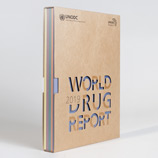Percent of People That Take Drugs and Do Them Again
World Drug Written report 2019: 35 1000000 people worldwide suffer from drug use disorders while just ane in 7 people receive treatment

Vienna, 26 June 2019 - Improved research and more precise data take revealed that the adverse health consequences of drug utilize are more astringent and widespread than previously thought. Globally, some 35 million people are estimated to suffer from drug use disorders and who require treatment services, according to the latest Earth Drug Report, released today by the United nations Role on Drugs and Crime (UNODC).
The higher estimates for 2017 are the result of improved cognition of the extent of drug employ from new surveys conducted in India and Nigeria, both amidst the ten most populous countries in the world.
The Written report also estimates the number of opioid users at 53 million, up 56 per cent from previous estimates [ane] , and that opioids are responsible for two thirds of the 585,000 people who died as a upshot of drug utilise in 2017. Globally, 11 million people injected drugs in 2017, of whom 1.iv million live with HIV and five.6 million with hepatitis C.
"The findings of this year'southward Earth Drug Report fill in and farther complicate the global picture of drug challenges, underscoring the demand for broader international cooperation to accelerate balanced and integrated health and criminal justice responses to supply and demand," said Yury Fedotov, UNODC Executive Director.
Severity and complication of World Drug Situation increasing
In 2017, an estimated 271 million people, or 5,five per cent of the global population aged fifteen-64, had used drugs in the previous year. While this is similar to the 2016 gauge, a longer-term view reveals that the number of people who use drugs is at present thirty per cent college than it was in 2009. Although that increase was in part due to a 10 per cent growth in the global population aged 15-64, data at present shows a higher prevalence of the use of opioids in Africa, Asia, Europe and North America and the use of cannabis in Northward America, Southward America and Asia compared with 2009.
Estimated global illicit manufacture of cocaine reached an best loftier of 1,976 tons in 2017, an increase of 25 per cent on the previous twelvemonth. At the same fourth dimension, the global quantity of cocaine seized in 2017 rose by 13 per cent to 1,275 tons, the largest quantity ever reported.
North America's synthetic opioid overdose crisis too reached new heights in 2017, with more than 47,000 opioid overdose deaths recorded in the U.s.a., an increase of xiii per cent from the previous year, and 4,000 opioid-related deaths in Canada, a 33 per cent increment from 2016.
Fentanyl and its analogues remain the key problem of the constructed opioid crisis in Due north America, merely West and Cardinal and North Africa are experiencing a crisis of another constructed opioid, tramadol. Global seizures of tramadol jumped from less than 10 kilograms in 2010 to almost nine tons in 2013 and reached a record high of 125 tons in 2017.
The nigh widely used drug globally continues to be cannabis, with an estimated 188 1000000 people having used the drug in 2017.
The Report shows that an area where the international community has had a degree of success is in addressing new psychoactive substances (NPS), evidenced past a decline in the number of NPS identified and reported for the showtime fourth dimension to UNODC. NPS take non been taken upwardly in the market to the extent feared a few years ago, and the international customs has reacted in a timely manner to assess the harms acquired by NPS and to schedule those that warranted international control.
Prevention and treatment continue to fall curt
Prevention and treatment go on to fall brusque in many parts of the world, with just one in seven people with drug use disorders receiving treatment each twelvemonth.
This is especially striking in prisons. This year's Report provides in-depth analysis of drug use and its adverse wellness consequences in prison house settings, which suggests that the prevalence of infectious diseases such every bit HIV, hepatitis C and active tuberculosis, and related risks, are disproportionately higher amongst prison house populations than among the general population, in particular among those who inject drugs in prison.
Fifty-six countries reported that they provided opioid substitution therapy in at least one prison house in 2017, while 46 countries reported non having such a treatment option in prison house settings. Needle-syringe programmes are far less bachelor in prison: 11 countries reported their availability in at least ane prison house, but such programmes were confirmed as absent in 83 countries.
The Report shows that effective treatment interventions based on scientific evidence and in line with international human rights obligations are not as available or accessible as they need to be, and national governments and the international community need to stride upwards interventions in order to address this gap.
***
The World Drug Study and further content is available hither: https://world wide web.unodc.org/wdr2019/
The 2019 Globe Drug Written report provides a global overview of the supply and demand of opiates, cocaine, cannabis, amphetamine-blazon stimulants and new psychoactive substances (NPS), also as their impact on health. It highlights, through improved inquiry and more precise information, that the adverse health consequences of drug use are more widespread than previously thought.
[one] In 2017, around 53.4 meg people worldwide had used opioids in the previous twelvemonth, 56 per cent more than than the estimate for 2016.
Source: https://www.unodc.org/unodc/en/frontpage/2019/June/world-drug-report-2019_-35-million-people-worldwide-suffer-from-drug-use-disorders-while-only-1-in-7-people-receive-treatment.html?ref=fs1
0 Response to "Percent of People That Take Drugs and Do Them Again"
Post a Comment